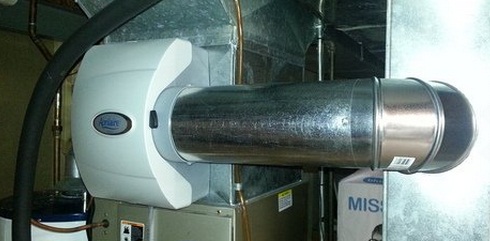
Getting a whole house humidifier installed in your home can help you keep the atmospheric moisture under control in all seasons.
But before you consider buying one for your home, apartment, or whole building, you should be knowledgeable enough about how these home appliances work, their common types, benefits, and the factors you need to check.
Here in this guide, we will try to address all your questions you may have in mind. Also, we list down the top available models on the market and their detailed reviews. So without any delay, let’s jump in…
What is a Whole House Humidifier?
A Whole House Humidifier or a Central Humidifier is a unit integrated and installed directly between your home’s central heating and cooling system (HVAC).
The most advantageous part of installing these types of humidifiers is that they are highly efficient and powerful to address the entire house instead of a single room or an individual location.
By pumping out the just-right amount of moisture into your ducts, these units help humidify your home or apartment appropriately (between 30 to 50 percent).
As these are specifically designed and hard-wired into a home’s plumbing and air heating systems, they let you enjoy balanced moisture in the home ambiance without any risk.
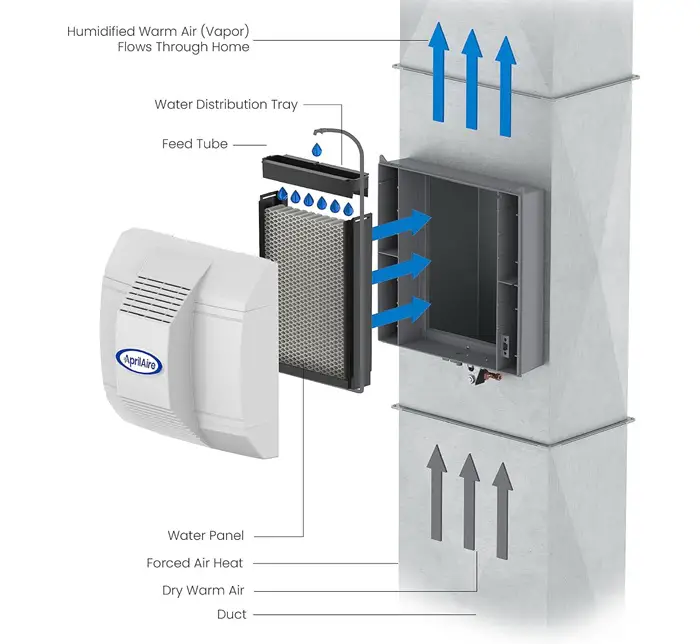
How does it work?
Unlike traditional humidifiers that are plugged into separate rooms, whole-house humidifiers are installed directly into heating ducts.
This provides the duct-based home humidification systems with easy access to every room in your house (including kitchen, bathroom, and even your small wine cellar at home), giving you ultimate control over the humidity of your home.
To control the humidity, your whole-house humidifier will add water vapor into the air. This water vapor rests inside your home’s heating ducts and waits for traveling air.
When the system is running, this traveling air will make its way through your heating ducts and join with the water vapor. The result is that the air being dispersed throughout your home has a higher humidity content.
7 Best Whole House Humidifier Reviews
Whole house humidifiers work in an automated way to provide optimum humidity, so these are also considered an “install it and forget it humidifier device for your home.”
Below are the top models and reviews that will help you in making the wisest decision. You can choose one from these top models or find one for yourself after comparing their best features online.
1- AprilAire 700 Automatic Furnace Humidifier

The AprilAire 700 is a powerhouse when it comes to keeping your entire home comfortable and healthy.
Designed and manufactured in the USA by the pioneers of whole-home humidifiers, it covers up to an impressive 5,300 sq. ft. and delivers up to 18 gallons of moisture per day, which is perfect for large or tightly built homes.
The digital controls in this smart AprilAire 700 Humidifier (which can also be accessed in manual mode) and its fully automatic operation are a standout feature that makes me appreciate how effortless it is to maintain the right humidity levels.
Once set, it quietly does its job without constant adjustments, giving me peace of mind that my home’s air is always at its healthiest and most comfortable.
With dual sensors monitoring both indoor humidity and outdoor temperature, it automatically adjusts moisture levels 24/7, eliminating the need for constant tweaking. Moreover, the built-in fan efficiently draws heated air from the furnace, ensuring even distribution throughout your space.
With just simple annual maintenance, you can keep all the irritating health issues away from your family members, which are usually caused due to dry, stale air.
Overall, AprilAire 700 is an ideal unit for homeowners seeking low-maintenance, whole-home comfort.
2- Aprilaire 500 Whole House Humidifier

If the AprilAire 700 is the heavy-duty choice for extra-large homes, the AprilAire 500 offers a more compact yet powerful solution for medium to large apartments.
Covering up to 3,600 sq. ft. and delivering 12 gallons of moisture per day, it’s ideal for those who want whole-home comfort in their tightly built homes without the oversized capacity of the 700.
Like its bigger sibling, the AprilAire 500 features dual sensors for fully automatic humidity control—just set it and let it work around the clock.
The convenient digital control panel displays current humidity levels, provides maintenance alerts, and even offers a blower activation option to run continuously or only when the furnace is on. Also, it tells you when it is time for a water change and servicing.
Furthermore, this humidification system for the furnace works quietly in your home without you knowing that you even have a humidifier in your home.
According to the necessity, it delivers the optimum amount of moisture into the air to control the indoor relative humidity levels 24/7 – simply set it and forget it!
3- AIRCARE MA Whole House Console Humidifier

The AIRCARE MA Console-Style Humidifier is a great choice for those who want whole-home humidity control without installing a furnace-connected system.
Designed for spaces up to 3,600 sq. ft., it uses cool mist evaporative technology to maintain a comfortable environment. Ideal for homeowners who want a plug-and-play whole-house humidifier with minimal setup.
What I like most about this AIRCARE MA Console Humidifier is its digital humidistat makes operation simple—just set your desired humidity level, and the unit will automatically maintain it.
The evaporative wick efficiently traps mineral deposits, making it easier to clean and ensuring smoother operation without belts, pulleys, or wheels.
Also, it shuts off on its own once the target is reached or when the water runs out, saving energy and hassle.
4- AIRCARE Pedestal-Style Evaporative Humidifier
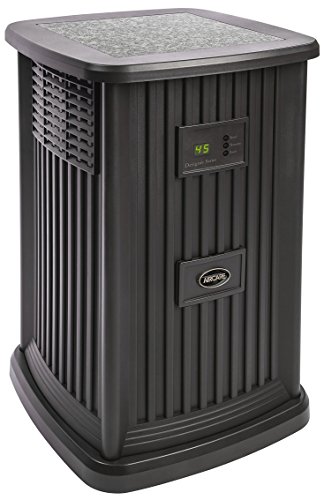
An AIRCARE Pedestal Style Evaporative Humidifier is meant for humidifying your whole house as it can cover up to 2,400 Square Feet of area.
This AIRCARE pedestal humidifier comes with a digital humidistat control to attain the desired humidity levels with digital accuracy.
It also features a Digital Readout Display which enables you to read the actual humidity level inside your home, and an automatic shut-off function when the water gets empty or the desired humidity level has been achieved.
Furthermore, this impressive humidifier is noiseless, environment-friendly, and decorative – you can replace the tile on the top with any standard 12″ x 12″ size tile or a decorative piece to match the décor of your room.
One great thing people love about this device is its 9-fan speed setting which allows them to select an ideal performance level – you can choose the setting based on your convenience level and requirement.
5- Honeywell Whole House Humidifier HE360A

As a brand speaks of itself, Honeywell HE360A is one of the best whole-house humidifiers (flow-through type) you can ever have for your home.
It can be easily mounted on either a warm air supply or a return air duct of any forced-air furnace. It is the best choice for those who want to get variable speed and multi-stage systems in homes up to 4500 square feet.
Honeywell HE360A Humidifier, with its flow-through humidification process, makes your home environment better to breathe in very efficiently.
The flow-through design of this unit demands very little maintenance as compared to other models and is therefore more affordable and easier to use. Also, installing this Honeywell HE360A humidifier is easy in your house.
6- Aprilaire 800 Residential Steam Humidifier

If you’re looking for serious humidity control beyond what the AprilAire 500 or 700 can handle, the AprilAire 800 Whole-House Steam Humidifier takes things to a whole new level.
Designed for expansive homes up to 10,300 sq. ft., it’s the go-to solution for high-demand environments where consistent moisture levels are crucial year-round.
Unlike evaporative models, the AprilAire 800 Residential Steam Humidifier utilizes advanced steam-based electrode technology, which means there’s no need for purified water and no filters to replace.
It automatically adjusts humidity using dual sensors that respond to both indoor humidity and outdoor temperature. With six output levels and the ability to add up to 34.6 gallons of moisture per day, this is a workhorse built for peak performance.
As this is a steam-type whole house humidifier, all the water that is delivered to the humidifier will either evaporate or go down the drain. This will leave the humidifier dry when it’s not working, thereby reducing the chances of mold growth.
Although not very common, it’s perfect for homeowners who want top-tier performance, especially in dry climates or multi-level homes.
The humidifier is also backed by 5 years of warranty on parts. You just need to ensure that you let the humidifier gets installed through a licensed technician to claim the warranty without any hassle.
7- DIGI MISTER Evaporative Humidifier
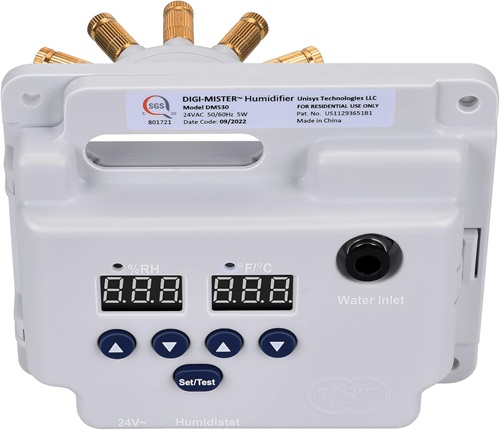
If you prefer a more flexible and water-efficient alternative to traditional whole-house humidifiers like the AprilAire series, the DIGI MISTER Evaporative Duct Mount Humidifier is worth considering.
Designed for spaces from 1,000 to 3,500 sq. ft., it offers adjustable capacity by simply changing the number of fine mist nozzles (1–5), tweaking water pressure, and optimizing warm air temperature. This makes it compatible with a variety of home sizes and furnace types.
Furthermore, the patented compact design of this DIGI MISTER Evaporative Humidifier allows installation in tight spaces without the need for extra ductwork or drainage.
Maintenance is user-friendly—nozzle spray can be checked through an observation window, tested remotely, and swapped easily with the included spares.
Full digital controls let you fine-tune humidity, duct temperature, and even calibration settings. Plus, its atomizing mist system uses no water pads, high-power fans, or costly steam canisters, saving both energy and maintenance costs.
Different Types Of Whole House Humidifiers
Whole-house (central) humidifiers are designed to add moisture to the air throughout your entire home using your HVAC (heating, ventilation, and air conditioning) system.
They differ in how they generate and deliver moisture. Here’s a detailed breakdown of the main types:
1. Bypass Humidifiers
A bypass humidifier is a cost-effective way to bring gentle, whole-home humidity into your living space. It works by channeling warm furnace air over a water panel, picking up moisture and recirculating it through your ducts.
With its simple, low-maintenance design and few moving parts, it’s built to last and easy to live with.
While it runs only when the furnace is on, it’s an excellent match for homes with moderate humidity needs, especially if you already have a forced-air furnace. Think of it as the “set it and forget it” option for comfortable, healthy air.
2. Fan-Powered Humidifiers
If you want a step up in performance without sacrificing space, the fan-powered humidifier delivers. By using its own built-in fan to push air across the water panel, it produces more moisture and can run independently of your furnace cycle.
This means consistent comfort, even in transitional seasons when heating isn’t running full-time. It’s efficient, compact, and designed for homes that need robust humidity control without the hassle of adding extra ductwork.
3. Steam Humidifiers
For those who want the gold standard in humidity control, steam humidifiers are unmatched. They create steam by boiling water and directly infuse it into your duct system—no waiting for furnace heat.
The result is precise, fast, and consistent humidity, perfect for protecting wood floors, fine furniture, or musical instruments. While the upfront cost is higher, the payoff is in performance, versatility, and the ability to keep large homes perfectly balanced year-round.
4. Drum Humidifiers
The drum humidifier is an old-school, budget-friendly workhorse. Its rotating foam drum draws water from a small reservoir while furnace air picks up the moisture. It’s simple to install, inexpensive, and works well in smaller setups.
However, it does need regular cleaning to prevent standing water issues. For homeowners looking for an affordable way to add comfort without complex upgrades, it’s still a valid choice, though newer models often provide better efficiency.
5. Spray Mist Humidifiers
Spray mist humidifiers are the minimalist’s option, using a fine water mist sprayed directly into the duct system. They’re straightforward and low-cost, but best reserved for very dry climates where evaporation happens quickly.
They require high-quality water to avoid mineral buildup and must be installed carefully to prevent moisture-related duct problems. While rare in modern homes, they can still be a practical choice in the right environment.
| Type | Cost | Humidity Output | Efficiency | Maintenance | Works Without Furnace Heat? |
|---|---|---|---|---|---|
| Bypass | Low | Moderate | Moderate | Low | No |
| Fan-Powered | Med | High | High | Low-Med | Yes |
| Steam | High | Very High | Very High | Med-High | Yes |
| Drum | Low | Low-Moderate | Low | High | No |
| Spray Mist | Low | Low | Low | Med | Yes (but risky) |
Whole House Console Humidifier vs. Whole House Furnace Humidifier – What’s the Better Option?
While the whole-house humidifiers that can be installed with your HVAC system are most common, there are also units available on the market, which may be referred to as console humidifiers or pedestal humidifiers.
The key difference between a whole-house console humidifier and a whole-house furnace (central) humidifier lies in how they are installed, how they deliver humidity, and how much space they can cover.
Although these are not integrated into your duct system, they are highly efficient in humidifying the larger areas, most of the time, which may cover your whole home. Just place them on the floor at a location that is far from the reach of your kids and at-home pets, sit relaxed, and forget you even own a regular humidifier device to care for.
Some of these whole-house console humidifier models can also be installed like a window or a wall mount unit, much like your room air conditioner. As these are portable, people also prefer using them for a single large room, a living room, a large business meeting or conference space, banquet halls, etc.
| Feature | Console Humidifier | Furnace (Central) Humidifier |
|---|---|---|
| Installation | No installation, plug-and-play | Professional HVAC installation |
| Water Supply | Manual fill (or optional line) | Direct plumbing connection |
| Coverage | Medium–large rooms or small homes | Entire home (large coverage) |
| Mobility | Portable | Fixed in HVAC system |
| Noise | Louder (built-in fan) | Quieter |
| Maintenance | Frequent refilling & cleaning | Annual pad/filter replacement |
| Cost | $150–$400 | $400–$1,500 (installed) |
| Best for | Homes without central HVAC, smaller homes, renters, or where permanent installation isn’t possible. | Homes with central heating/cooling that need consistent, whole-home humidity control. |
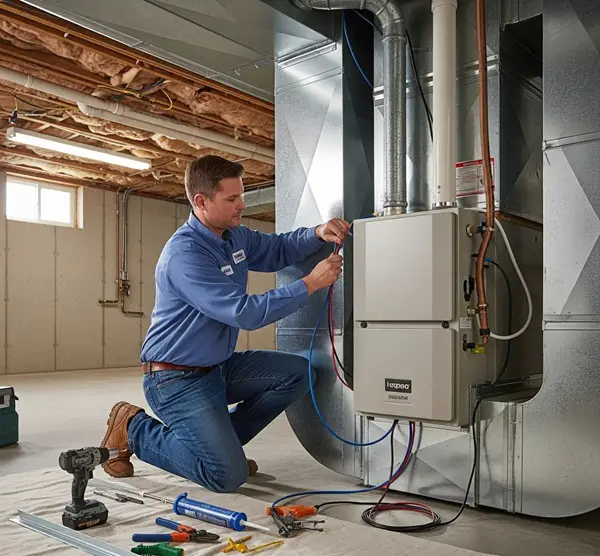
Benefits of Installing a Whole House Humidifier Unit
Central humidifiers (or so-called whole-house humidifiers) are most recommended for home use in winter to improve indoor air quality.
Some of the best advantages of getting these systems installed in your central air ducts are:
✅ Do Not Over-Humidify: It has been seen that many portable units do not stop humidifying the air even when the necessary humidity level has been achieved. This is due to the fact that these room humidifier lacks humidity control regulators or regulating features.
Whole house humidifiers, being a smart device, work automatically to provide the necessary humidification only when needed; it does not over-humidify your room. This saves you from all types of mold, mildew, and dust mites that may grow due to increased humidity in the air.
✅ Low Maintenance: One of the disadvantages of using a portable room humidifier is that it requires changing the water daily. Regular cleaning of filters is also essential for removing the white dust mineral deposits, which are deposited as a result of evaporated tap water containing minerals.
Moreover, you need to clean the reservoir (and other parts), along with thoroughly drying the tank of these stand-alone devices to prevent viruses and mold from growing.
On the other hand, whole-house humidifiers save you from all these troubles of cleaning the unit and regular maintenance. You can get your unit serviced once a year, which makes it run smoothly all the time.
✅ Low Operating Cost: As mentioned before, many portable room humidifiers do not include a built-in hygrometer to stop the unit after they have delivered optimum humidity in the room. This leads to wastage of power and hence higher electric bills.
However, in the case of central humidifying systems, these humidifiers with built-in humidistats come with a sensor to control humidity. This enables them to run automatically only when required (to achieve the targeted humidity).
It does not keep running all the time, 24×7, and this controlled feature to humidify the home saves a good monthly amount on your electricity bills.
Besides the power bills, room humidifier units need expensive distilled water to operate efficiently and to prevent the deposition of white dust minerals. Whole-house humidifiers, on the other hand, do not require any such purified water for operation and can save on your water purifier bills.
What setting should you use with the humidistat on the furnace?
Your humidistat on the furnace needs to be set at an appropriate level before you can enjoy its maximum benefits in winter and in various other seasons.
While for most homes, the comfortable relative humidity level is between 30 percent and 50 percent, it may also sometimes depend on the outdoor environmental conditions and temperature.
Based on the temperature, you should, therefore, set the humidistat on your furnace between these ranges.
What is the Cost of Installing a Whole House Humidifier?
Installing a whole-house humidifier typically costs $350–$2,000+, depending on the type and complexity.
Bypass humidifiers are the most affordable, fan-powered models cost a bit more, while steam humidifiers are the most expensive due to their high output and complex installation.
Labor charges range from $150–$450, with extra costs if new ductwork, water lines, or electrical wiring are needed. Portable console humidifiers cost $250–$500 and don’t require professional installation.
Annual maintenance is minimal — usually replacing the evaporator pad for $15–$50, or a bit more for steam units, which need descaling. For savings, it’s best to install the humidifier during a furnace or AC replacement, as labor costs can be significantly reduced.
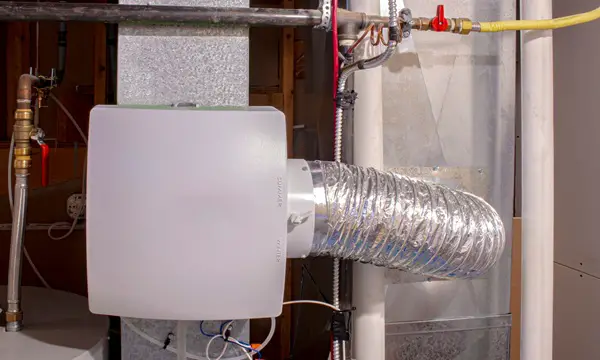
Factors to Look at When Buying a Whole-House Humidification System
Buying a correct home appliance, like a whole-house humidifier, can be a real headache.
Worse is the condition when you buy the wrong device that does not get installed correctly to provide you with the desired results.
Here are a few essential tips for you to look at before purchasing your humidifying unit and getting the installation done.
✓ Quality and brand:
Purchasing an expensive air maintenance device does not mean that it will offer the best performance to you for decades. You have to research the available humidifier types thoroughly, check the most reliable brands, and decide which one to choose.
Since these whole-house humidification systems do not come cheap, you also need to check whether they come with a proper warranty or not.
Although the above brands and units are best to opt for, many more popular manufacturers are popular for making these appliances. Some of the popular names are Bryant, Bionaire, Kenmore, Holmes, Lowes, Lasko, Lennox, Menards, Sears, Sunbeam, and Trane.
✓ Size of the area covered:
This is important for you and can be done by investing a few minutes before your purchase. You just need to figure out the proper cubic footage of your home and accordingly buy a device that meets your requirements perfectly well.
At times, if you do not want to humidify your whole apartment, you may simply opt for a large-sized humidifier, which is good enough to cover a large room in your home. Instead of investing huge amounts in installing a whole-house humidifier, investing in this type of unit can save you good bucks, which you may have spent uselessly.
✓ Your location:
For many of us, this may sound awkward. But this is one of the most essential factors you may need to consider when buying a whole-house humidifier for your HVAC system.
Installing an HVAC humidifier is usually not recommended in areas where the Mercury may drop below the freezing point during cold winters.
Freezing water can cause failure in your ducts, pipes, seals, and joints, and it is therefore important that you do not install this type of device in basements or attics where the possibility of dropping temperatures is quite high.
✓ Maintenance needed:
It is often very tempting for people to choose a device that needs less maintenance.
While there is no harm in choosing such a unit, at the same time, you have to ensure that the system you are buying is user-friendly. It should also come with the latest features and a proper warranty.
Most of the branded humidifiers mentioned above are easy to use, install and maintain. These may require annual maintenance, which should be done by hiring an experienced professional.
The Conclusion
Choosing the right whole house humidifier ultimately comes down to your home’s setup, your comfort needs, and your budget.
Whether you opt for a portable model like the Honeywell HE360A or a central system from trusted brands such as Aprilaire or AIRCARE, the goal is the same — to maintain an ideal indoor humidity level of 30–50%, as recommended by the EPA.
Staying within this range helps prevent dryness, protects wood furnishings, and avoids problems like mold growth from excess moisture. With the right system in place, you can enjoy a healthier, more comfortable living environment year-round.
Meen Smith is a nurse by profession who loves writing online, spending time with her family and caring for the elderly. She has already worked as an associate editor on various moms, babies, home appliances, kitchen, and healthy living blogs. In her spare time, she also enjoys drawing, reading/writing kindle eBooks and improving her skills a bit.
